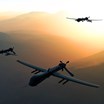
Built to evolve: Why Open Standards must define the future of Electromagnetic Warfare
Ever since its inception in the 20th Century, Electromagnetic Warfare (EW) has transformed the battlefield. Despite its first documented use being traced back to the Russo-Japanese War, it wasn’t until World War II that the use of radar, jamming and signals intelligence became prominent.
Today, EW is a vital component of modern military operations: it plays a pivotal role in ensuring strategic dominance across air, land, sea, space, and cyber domains. However, until recent years, EW’s advancement has been somewhat neglected.
The Russian invasion of Ukraine in 2022 has put the spotlight back on EW. Unlike other nations, Russia continued to invest in EW. Lacking the sheer numbers to mobilise a conventional army capable of matching Russia's forces, Ukraine prioritised its Electronic Survelliance (ES) and Electronic Attack (EA) strategies, with drones emerging as a cornerstone of its approach. These unmanned aerial systems have been pivotal in gathering intelligence, disrupting enemy operations, and launching strikes.
Open Standards: A Paradigm Shift
It’s clear that as the nature of conflict globally continues to rapidly grow more interconnected and dynamic, traditional approaches to EW, rooted in restrictive proprietary systems, will not keep pace. As the battlefield evolves, so must our approach to EW.
Open standards represent a paradigm shift, offering the flexibility, interoperability, and collaboration necessary to address these challenges head-on. Here, we explore how open standards, when integrated into a modular platform, can enhance the operational effectiveness of EW, driving innovation, and safeguarding military systems against emerging threats.
Rising to the Pace of Modern Warfare
Modern warfare evolves in mere hours, demanding rapid development and deployment — critical during conflict and preparation. Ukraine’s swift adaptation of fibre-optic drone technology, which is impossible to jam, to counter Russia’s fibre-optic drones illustrates this particularly well.
This new pace of technological advancements simply can’t be achieved through legacy systems, which are typically designed for a single mission and offer limited scope for upgrades or customisation.
Open standards are key to facilitating a more scalable, modular system design that can adapt to support multiple mission roles. With defined, common interfaces across both hardware and software, open standards-based systems provide a universal standard. In practice, this means that the system can be adapted easily with a ‘plug-in-and-go’ approach. For example, new functionality can be quickly and easily integrated and interchanged.
Powering Innovation with a Shared Framework
To deliver capability at the speed of operational demand, industry advocates must look to build an innovative framework. Open standards provide the perfect environment: by creating an open standards template and sharing its ownership with industry and defence partners, it’s possible to harness a community of complementary collaborators to create technology enablers capable of delivering effective and enduring systems.
As other nations seek to strengthen their defenses, adopting a collaborative, open standards-based approach could prove game-changing. Open standards not only open up a wider supplier base, but they also provide a shared framework that bridges gaps between military organisations, industry players, and international allies. Importantly, with a universal approach, integration with third-party technologies, like sensors and effectors which can heighten EW capabilities, is streamlined and quick to commission.
Preparing for Tomorrow’s Battlefield
The size and complexity of modern operations is diverse and increasingly technology driven. We are only beginning to understand how AI, autonomy and digitisation will impact how our forces operate. However, the more digitised and network dependent the battlefield becomes, the more important it is that our sensors and effectors can be reprogrammed rapidly. This ensures they stay adaptable and continue to enable decision advantage in the Electromagnetic Spectrum.
Investing in modular, open standards-based systems offers military organisations with a long-term solution. By leaving room for capability insertion, organisations will be able to improve their EW solutions over time, respond to change efficiently, and, ultimately, operate more cost effectively. By prioritising open standards today, nations can ensure their forces remain agile and effective in the conflicts of tomorrow.
At Roke, we firmly believe that the future of EW lies in open, evergreen solutions. Our electromagnetic warfare, surveillance and attack solutions make it possible to find, fix and disrupt an adversary’s radio, radar and other communications emissions, and interpret and exploit them for strategic and tactical decision-making. And we’re not stopping there: we’re continually advancing our EW solutions to adapt to today’s data-driven, information-led warfare. Watch this space.
Are you at the AOC International Symposium & Convention this year? Come by the Roke stand B06 and let's have a chat about how we’re changing the face of EW.

Changing Worlds through collaboration in defence
Integrating autonomy and AI into defence operations will mark a pivotal shift in how militaries approach efficiency and effectiveness. By streamlining decision-making, enhancing battlefield capabilities, and planning for long-term sustainability, these technologies have the potential to reshape the defence landscape for good – from supply chain to operations. As the sector continues to evolve, the emphasis on interoperability, collaboration, and real-time data will be critical in maintaining a strategic edge against emerging hybrid threats that will emerge and increase in frequency as time goes by.
Related news, insights and innovations
Find out more about our cutting-edge expertise.






































